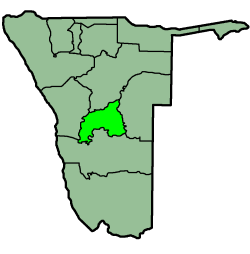Khomas Highland
| Khomas Region | |
|---|---|
| Region | |
 Location of the Khomas Region in Namibia |
|
| Country | Namibia |
| Capital | Windhoek |
| Government | |
| • Governor | Laura McLeod-Katjirua |
| Area | |
| • Total | 36,964 km2 (14,272 sq mi) |
| Population (2011) | |
| • Total | 340,900 |
| • Density | 9.2/km2 (24/sq mi) |
| Time zone | South Africa Standard Time: UTC+2 |
Khomas is one of the fourteen regions of Namibia. Its name refers to the Khomas Highland, a high plateau landscape that dominates this administrative unit. Khomas is centered on the capital city Windhoek and provides for this reason superior transportation infrastructure. It is located in the central highlands of the country and is bordered by the Erongo region to the west and the northwest and by the Otjozondjupa region to the north. To the east is the Omaheke region, while in the south is the Hardap region. The region is characterized by its hilly countrysize and many valleys. It has well-developed economical, financial, and trade sectors. Khomas Region occupies 4.5% of the land area of Namibia but has the highest population of any of its regions (15%). Khomas is one of only three Namibian regions to have neither shoreline nor a foreign border.
The Governor of Khomas Region is Laura McLeod-Katjirua. The region comprises ten constituencies:
Khomas is important electorally, as nearly 17% of the total votes in the 2004 election came from this region.
SWAPO won Khomas Region by a wide majority, though with a lower percentage of the total vote than nationally.
In the 2015 regional elections Swapo won in all ten constituencies.
Khomas has 100 schools with a total of 73,302 pupils.
According to the Namibia 2001 Population and Housing Census, Khomas had a population of 250,262 (123,613 females and 126,648 males or 102 males for every 100 females) growing at an annual rate of 4%. The fertility rate was 4.9 children per woman. 93% lived in urban areas while 7% lived in rural areas, and with an area of 37,007 km2, the population density was 6.8 persons per km2. By age, 11% of the population was under 5 years old, 18% between 5–14 years, 67% between 15–59 years, and 4% 60 years and older. The population was divided into 58,580 households, with an average size of 4.2 persons. 36% of households had a female head of house, while 64% had a male. For those 15 years and older, 61% had never married, 24% married with certificate, 3% married traditionally, 7% married concensually, 2% were divorced or separated, and 2% were widowed. White Namabians and Colourds form one third of the population of this region.
...
Wikipedia
